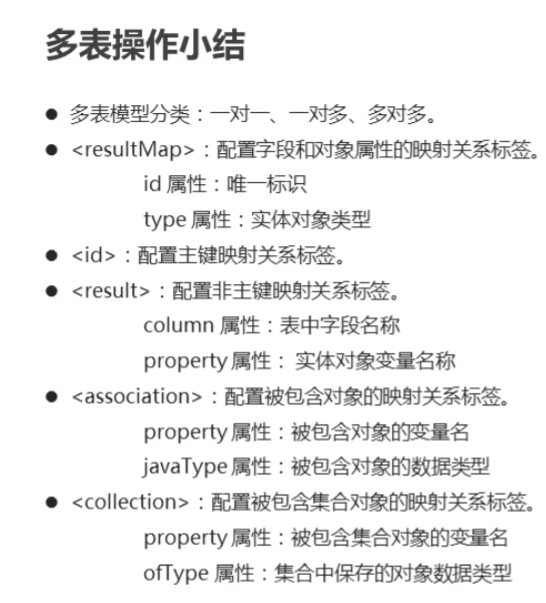MyBatis的多表操作
# 1.1 多表模型介绍
随着业务难度的加深,肯定需要多表操作的。
- 多表模型分类 一对一:在任意一方建立外键,关联对方的主键。
- 一对多:在多的一方建立外键,关联一的一方的主键。
- 多对多:借助中间表,中间表至少两个字段,分别关联两张表的主键。
# 1.2 多表模型一对一操作
一对一模型: 人和身份证,一个人只有一个身份证
代码实现
步骤一: sql语句准备
CREATE TABLE person( id INT PRIMARY KEY AUTO_INCREMENT, NAME VARCHAR(20), age INT ); INSERT INTO person VALUES (NULL,'张三',23); INSERT INTO person VALUES (NULL,'李四',24); INSERT INTO person VALUES (NULL,'王五',25); CREATE TABLE card( id INT PRIMARY KEY AUTO_INCREMENT, number VARCHAR(30), pid INT, CONSTRAINT cp_fk FOREIGN KEY (pid) REFERENCES person(id) ); INSERT INTO card VALUES (NULL,'12345',1); INSERT INTO card VALUES (NULL,'23456',2); INSERT INTO card VALUES (NULL,'34567',3);1
2
3
4
5
6
7
8
9
10
11
12
13
14
15
16
17
18步骤二:配置文件
<?xml version="1.0" encoding="UTF-8" ?> <!DOCTYPE mapper PUBLIC "-//mybatis.org//DTD Mapper 3.0//EN" "http://mybatis.org/dtd/mybatis-3-mapper.dtd"> <mapper namespace="com.itheima.table01.OneToOneMapper"> <!--配置字段和实体对象属性的映射关系--> <resultMap id="oneToOne" type="card"> <id column="cid" property="id" /> <result column="number" property="number" /> <!-- association:配置被包含对象的映射关系 property:被包含对象的变量名 javaType:被包含对象的数据类型 --> <association property="p" javaType="person"> <!--主键用id 其余字段是result--> <id column="pid" property="id" /> <result column="name" property="name" /> <result column="age" property="age" /> </association> </resultMap> <select id="selectAll" resultMap="oneToOne"> SELECT c.id cid,number,pid,NAME,age FROM card c,person p WHERE c.pid=p.id </select> </mapper>1
2
3
4
5
6
7
8
9
10
11
12
13
14
15
16
17
18
19
20
21
22
23
24
25
26
27步骤三:测试类
@Test public void selectAll() throws Exception{ //1.加载核心配置文件 InputStream is = Resources.getResourceAsStream("MyBatisConfig.xml"); //2.获取SqlSession工厂对象 SqlSessionFactory sqlSessionFactory = new SqlSessionFactoryBuilder().build(is); //3.通过工厂对象获取SqlSession对象 SqlSession sqlSession = sqlSessionFactory.openSession(true); //4.获取OneToOneMapper接口的实现类对象 OneToOneMapper mapper = sqlSession.getMapper(OneToOneMapper.class); //5.调用实现类的方法,接收结果 List<Card> list = mapper.selectAll(); //6.处理结果 for (Card c : list) { System.out.println(c); } //7.释放资源 sqlSession.close(); is.close(); }1
2
3
4
5
6
7
8
9
10
11
12
13
14
15
16
17
18
19
20
21
22
23
24
25
26
3.一对一配置总结:
<resultMap>:配置字段和对象属性的映射关系标签。 id 属性:唯一标识 type 属性:实体对象类型 <id>:配置主键映射关系标签。 <result>:配置非主键映射关系标签。 column 属性:表中字段名称 property 属性: 实体对象变量名称 <association>:配置被包含对象的映射关系标签。一对一 property 属性:被包含对象的变量名 javaType 属性:被包含对象的数据类型1
2
3
4
5
6
7
8
9
10
# 1.3 多表模型一对多操作
一对多模型: 一对多模型:班级和学生,一个班级可以有多个学生。
代码实现
步骤一: sql语句准备
CREATE TABLE classes( id INT PRIMARY KEY AUTO_INCREMENT, NAME VARCHAR(20) ); INSERT INTO classes VALUES (NULL,'黑马一班'); INSERT INTO classes VALUES (NULL,'黑马二班'); CREATE TABLE student( id INT PRIMARY KEY AUTO_INCREMENT, NAME VARCHAR(30), age INT, cid INT, CONSTRAINT cs_fk FOREIGN KEY (cid) REFERENCES classes(id) ); INSERT INTO student VALUES (NULL,'张三',23,1); INSERT INTO student VALUES (NULL,'李四',24,1); INSERT INTO student VALUES (NULL,'王五',25,2); INSERT INTO student VALUES (NULL,'赵六',26,2);1
2
3
4
5
6
7
8
9
10
11
12
13
14
15
16
17
18
19步骤二:配置文件
<mapper namespace="com.itheima.table02.OneToManyMapper"> <resultMap id="oneToMany" type="classes"> <id column="cid" property="id"/> <result column="cname" property="name"/> <!-- collection:配置被包含的集合对象映射关系 property:被包含对象的变量名 ofType:被包含对象的实际数据类型 --> <collection property="students" ofType="student"> <id column="sid" property="id"/> <result column="sname" property="name"/> <result column="sage" property="age"/> </collection> </resultMap> <select id="selectAll" resultMap="oneToMany"> SELECT c.id cid,c.name cname,s.id sid,s.name sname,s.age sage FROM classes c,student s WHERE c.id=s.cid </select> </mapper>1
2
3
4
5
6
7
8
9
10
11
12
13
14
15
16
17
18
19
20步骤三:测试类
@Test public void selectAll() throws Exception{ //1.加载核心配置文件 InputStream is = Resources.getResourceAsStream("MyBatisConfig.xml"); //2.获取SqlSession工厂对象 SqlSessionFactory sqlSessionFactory = new SqlSessionFactoryBuilder().build(is); //3.通过工厂对象获取SqlSession对象 SqlSession sqlSession = sqlSessionFactory.openSession(true); //4.获取OneToManyMapper接口的实现类对象 OneToManyMapper mapper = sqlSession.getMapper(OneToManyMapper.class); //5.调用实现类的方法,接收结果 List<Classes> classes = mapper.selectAll(); //6.处理结果 for (Classes cls : classes) { System.out.println(cls.getId() + "," + cls.getName()); List<Student> students = cls.getStudents(); for (Student student : students) { System.out.println("\t" + student); } } //7.释放资源 sqlSession.close(); is.close(); }1
2
3
4
5
6
7
8
9
10
11
12
13
14
15
16
17
18
19
20
21
22
23
24
25
26
27
28
29
3.一对多配置文件总结:
<resultMap>:配置字段和对象属性的映射关系标签。
id 属性:唯一标识
type 属性:实体对象类型
<id>:配置主键映射关系标签。
<result>:配置非主键映射关系标签。
column 属性:表中字段名称
property 属性: 实体对象变量名称
<collection>:配置被包含集合对象的映射关系标签。
property 属性:被包含集合对象的变量名
ofType 属性:集合中保存的对象数据类型
1
2
3
4
5
6
7
8
9
10
2
3
4
5
6
7
8
9
10
# 1.4 多表模型多对多操作
多对多模型:学生和课程,一个学生可以选择多门课程、一个课程也可以被多个学生所选择。
代码实现
步骤一: sql语句准备
CREATE TABLE course( id INT PRIMARY KEY AUTO_INCREMENT, NAME VARCHAR(20) ); INSERT INTO course VALUES (NULL,'语文'); INSERT INTO course VALUES (NULL,'数学'); CREATE TABLE stu_cr( id INT PRIMARY KEY AUTO_INCREMENT, sid INT, cid INT, CONSTRAINT sc_fk1 FOREIGN KEY (sid) REFERENCES student(id), CONSTRAINT sc_fk2 FOREIGN KEY (cid) REFERENCES course(id) ); INSERT INTO stu_cr VALUES (NULL,1,1); INSERT INTO stu_cr VALUES (NULL,1,2); INSERT INTO stu_cr VALUES (NULL,2,1); INSERT INTO stu_cr VALUES (NULL,2,2);1
2
3
4
5
6
7
8
9
10
11
12
13
14
15
16
17
18
19步骤二:配置文件
<?xml version="1.0" encoding="UTF-8" ?> <!DOCTYPE mapper PUBLIC "-//mybatis.org//DTD Mapper 3.0//EN" "http://mybatis.org/dtd/mybatis-3-mapper.dtd"> <mapper namespace="com.itheima.table03.ManyToManyMapper"> <resultMap id="manyToMany" type="student"> <id column="sid" property="id"/> <result column="sname" property="name"/> <result column="sage" property="age"/> <collection property="courses" ofType="course"> <id column="cid" property="id"/> <result column="cname" property="name"/> </collection> </resultMap> <select id="selectAll" resultMap="manyToMany"> SELECT sc.sid,s.name sname,s.age sage,sc.cid,c.name cname FROM student s,course c,stu_cr sc WHERE sc.sid=s.id AND sc.cid=c.id </select> </mapper>1
2
3
4
5
6
7
8
9
10
11
12
13
14
15
16
17
18
19
20步骤三:测试类
@Test public void selectAll() throws Exception{ //1.加载核心配置文件 InputStream is = Resources.getResourceAsStream("MyBatisConfig.xml"); //2.获取SqlSession工厂对象 SqlSessionFactory sqlSessionFactory = new SqlSessionFactoryBuilder().build(is); //3.通过工厂对象获取SqlSession对象 SqlSession sqlSession = sqlSessionFactory.openSession(true); //4.获取ManyToManyMapper接口的实现类对象 ManyToManyMapper mapper = sqlSession.getMapper(ManyToManyMapper.class); //5.调用实现类的方法,接收结果 List<Student> students = mapper.selectAll(); //6.处理结果 for (Student student : students) { System.out.println(student.getId() + "," + student.getName() + "," + student.getAge()); List<Course> courses = student.getCourses(); for (Course cours : courses) { System.out.println("\t" + cours); } } //7.释放资源 sqlSession.close(); is.close(); }1
2
3
4
5
6
7
8
9
10
11
12
13
14
15
16
17
18
19
20
21
22
23
24
25
26
27
28
29
30
31
3.多对多配置文件总结:
<resultMap>:配置字段和对象属性的映射关系标签。 id 属性:唯一标识 type 属性:实体对象类型 <id>:配置主键映射关系标签。 <result>:配置非主键映射关系标签。 column 属性:表中字段名称 property 属性: 实体对象变量名称 <collection>:配置被包含集合对象的映射关系标签。 property 属性:被包含集合对象的变量名 ofType 属性:集合中保存的对象数据类型1
2
3
4
5
6
7
8
9
10
# 1.5 多表模型操作总结
<resultMap>:配置字段和对象属性的映射关系标签。
id 属性:唯一标识
type 属性:实体对象类型
<id>:配置主键映射关系标签。
<result>:配置非主键映射关系标签。
column 属性:表中字段名称
property 属性: 实体对象变量名称
<association>:配置被包含对象的映射关系标签。
property 属性:被包含对象的变量名
javaType 属性:被包含对象的数据类型
<collection>:配置被包含集合对象的映射关系标签。
property 属性:被包含集合对象的变量名
ofType 属性:集合中保存的对象数据类型
1
2
3
4
5
6
7
8
9
10
11
12
13
2
3
4
5
6
7
8
9
10
11
12
13

上次更新: 2023/09/05 17:45:42
